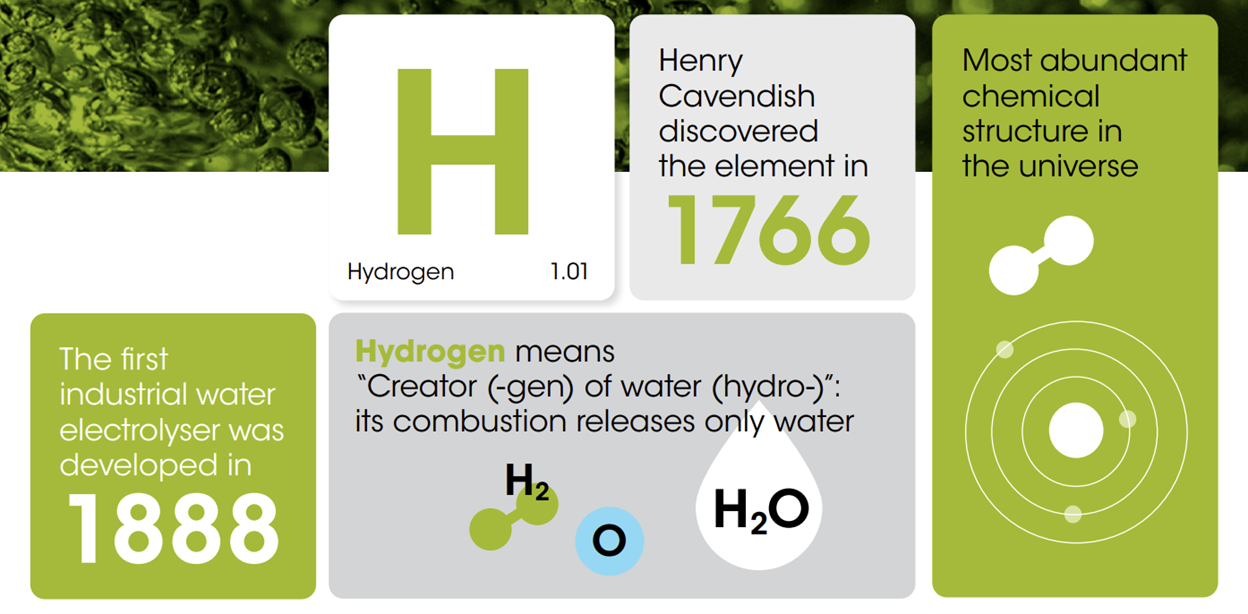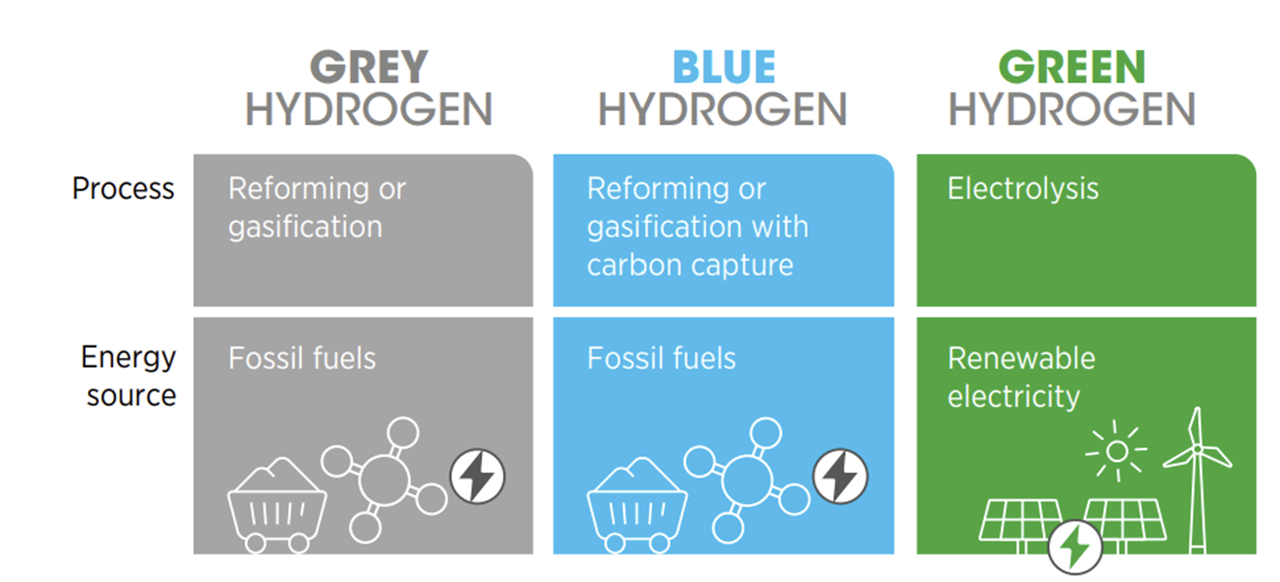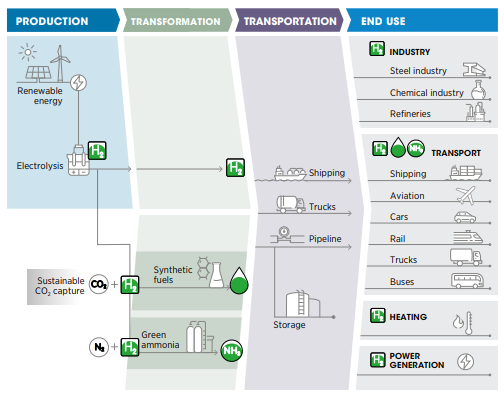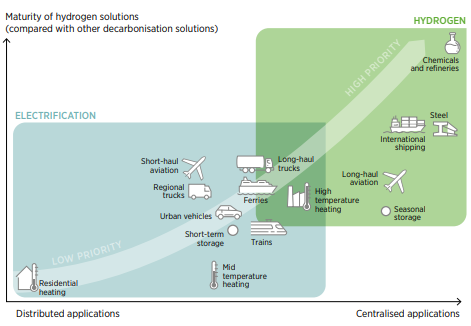Overview
Hydrogen is the oldest, lightest and most abundant element in the universe. As a gas it is an ultra-light energy carrier, and when it is burned the only emission it produces is water vapour. Hydrogen can also be used in fuel cells, where it chemically reacts with oxygen to produce electricity, without emitting any pollutants or greenhouse gases. The only by-product of this chemical reaction is pure drinkable water. But the main use of hydrogen currently is as a feedstock for industry.

Hydrogen production
Despite its abundance on Earth, hydrogen does not exist naturally in its pure form in large quantities. There are no vast deposits of hydrogen in the ground that can be extracted. Hydrogen is found almost exclusively in compounds, notably water molecules (hydrogen and oxygen) and fossil fuels (hydrogen and carbon). Hydrogen can be released from these compounds, but doing so requires energy. A colour code nomenclature is becoming commonly used to facilitate discussion:
- Grey hydrogen is produced with fossil fuels (e.g. hydrogen produced from methane using steam methane reforming or coal gasification). The use of grey hydrogen entails substantial CO2 emissions, which makes these hydrogen technologies unsuitable for a route towards net zero emissions. Moreover, the use of fossil gas brings the risk of leakages of methane, a potent greenhouse gas. Around three-quarters of hydrogen is currently produced from fossil gas.
- Blue hydrogen has the same production process as grey hydrogen, but is complemented by carbon capture and storage. Blue hydrogen can yield very low greenhouse gas emissions, but only if methane leakage does not exceed 0.2%, with close to 100% carbon capture. Such rates are still to be demonstrated at scale.
- Green hydrogen is produced from renewable energy and is the hydrogen most appropriate for a fully sustainable energy transition. The most established technology option for producing green hydrogen is water electrolysis fuelled by renewable electricity. Other renewables-based solutions to produce hydrogen are possible, but these technologies are not yet technically mature for production on a commercial scale.
Hydrogen colours

Uses of hydrogen
Hydrogen gas is used mainly as a feedstock for the (petro)chemical industry, including crude oil refining, ammonia synthesis (primarily for fertiliser production) and methanol production for a wide variety of products (including plastics). Hydrogen can also be used as a fuel. When burned, it can generate heat of more than 1 000°C without emitting CO2. Further, hydrogen can be used in fuel cells, where it chemically reacts with oxygen to produce electricity without emitting any pollutants or greenhouse gases. The only by-product of this chemical reaction is water vapour.
Green hydrogen value chain

Hydrogen is currently used mostly in oil refineries to remove impurities, to upgrade heavy oil fractions in chemical production and as a reducing agent in iron making. Industry demand for hydrogen was 87.1 Mt in 2020.
Under IRENA’s 1.5°C Scenario, by 2050 hydrogen demand reaches 613 Mt (74 EJ), at least two-thirds of which should be green hydrogen. The electricity demand to produce hydrogen will reach almost the level of global electricity consumption today.
This requires significant scale-up of electrolyser manufacturing, renewable energy capacity and deployment. Around 160 GW of electrolysers need to be installed annually on average up to 2050. The installation rate starts growing from a few gigawatts added per annum in the coming years and then significantly ramps up from 2030 onwards.
Policies to support green hydrogen
The green hydrogen industrial sector is in its infancy, yet to become competitive with grey hydrogen. As with many infant industries, it therefore needs dedicated industrial policy making.
Industrial policies can take many forms; they can actively force the hand of industrial stakeholders to change the status quo, make the fossil fuel option unattractive for investors, or provide a supportive environment to attract investment in green hydrogen. Supportive policies have been widely used in the energy sector to promote the deployment of renewable electricity through support schemes, and these can offer many lessons for green hydrogen. Transitioning green hydrogen from a niche player to a widespread energy carrier will require an integrated policy approach to overcome initial resistance and reach a minimum threshold for market penetration. That policy approach should have four central pillars:
- National hydrogen strategy. Each country needs to define its level of ambition for hydrogen, outline the pathway to reach the ambition and the amount of support required, and provide a reference point on hydrogen development for private investment and finance.
- Policy priorities. Green hydrogen can support a wide range of end uses. Policy makers should identify and focus on applications that provide the highest value.
- Guarantees of origin. The carbon emissions assigned to hydrogen production and transportation should reflect its whole life cycle. Origin schemes need to include clear emission labelling for hydrogen and hydrogen products to increase consumer awareness and facilitate carbon reduction incentives.
- Governance system and enabling policies. As green hydrogen becomes mainstream, policies should cover its integration into the broader energy system. Civil society and industry must be involved to maximise the benefits.
Policies to support electrolysers
Reducing GHG emissions in hard-to-abate sectors through the use of green hydrogen will require large amounts of it, larger than what is available from current (mostly grey) hydrogen production. That, in turn, requires a rapid scale-up in the number and overall capacity of electrolysers used to make hydrogen. The roadmap described in IRENA’s 2022 World Energy Transitions Outlook foresees a total installed electrolyser capacity of 5 TW by 2050, up from today’s 300 MW. National hydrogen strategies usually feature targets for electrolyser capacity by 2030, with varying degrees of commitment. Target setting can ensure the appropriate parallel development of renewable energy and electrolyser capacity.
Still, supportive policies will be needed to both meet and exceed such targets and achieve the necessary installed capacity by 2050.
Policies to support industrial uses
The industrial sector is the leading consumer of hydrogen. Hydrogen is used in refineries, the chemical industry and steelmaking, all categorised as “hard-to-abate” sectors. This large and centralised core of demand is critical for developing a green hydrogen sector.
However, several barriers impede green hydrogen’s full contribution to the industrial sector, including cost, technical obstacles, policy, lack of demand and carbon leakage risk. Policy makers can adopt industrial policies that address these barriers and oblige or support a change from fossil fuel dependency in hard-to-abate sectors. This is an urgent task given the long lifespan of industrial assets and the limited window to limit the climate crisis.
Industrial users of hydrogen should be among the first recipients of green hydrogen, given the lack of alternative decarbonisation solutions and the potential size of local hydrogen demand. The figure below compares possible end uses by the size of application and the maturity of hydrogen-based solutions (compared with electricity-based solutions). Policy development should focus on the more mature and centralised hydrogen solutions, a process that can involve dedicated research, planning and support.
Green hydrogen priorities

Current policy status
A growing number of countries and companies are engaged in intense competition for leadership in clean hydrogen technologies. In 2017 just one country (Japan) had a national hydrogen strategy. Today, more than 30 countries have developed or are preparing hydrogen strategies, indicating growing interest in developing hydrogen value chains.
More will have to be done to support green hydrogen. IRENA is building on its role of supporting policy makers to create an enabling environment for green hydrogen to become one of the pillars of the energy transition.
Past Events
More events-
11 December 2024 Virtual
Policies and measures for green hydrogen deployment in Türkiye
-
19 November 2024 Virtual
Workshop for Green Hydrogen in the Islamic Republic of IRAN






